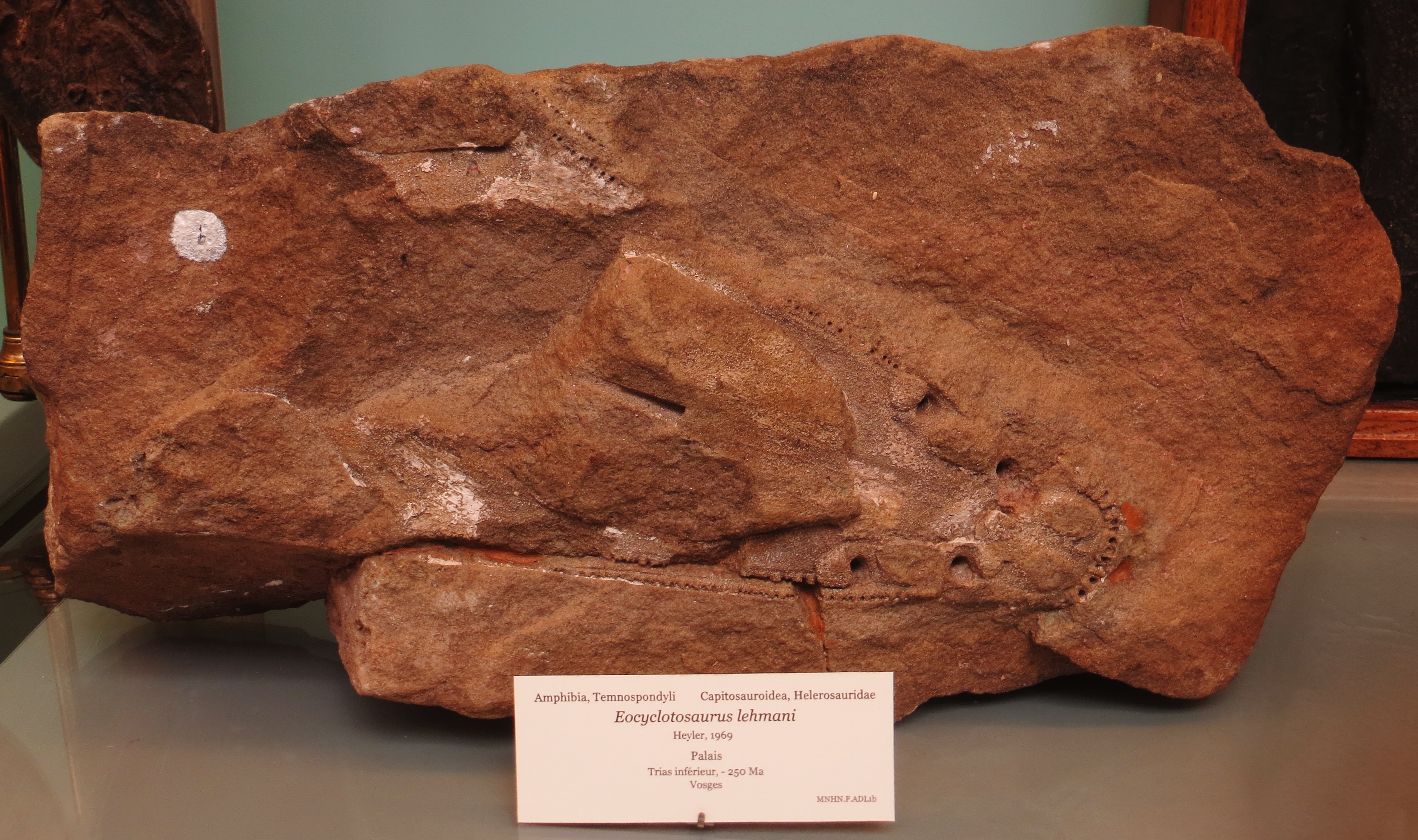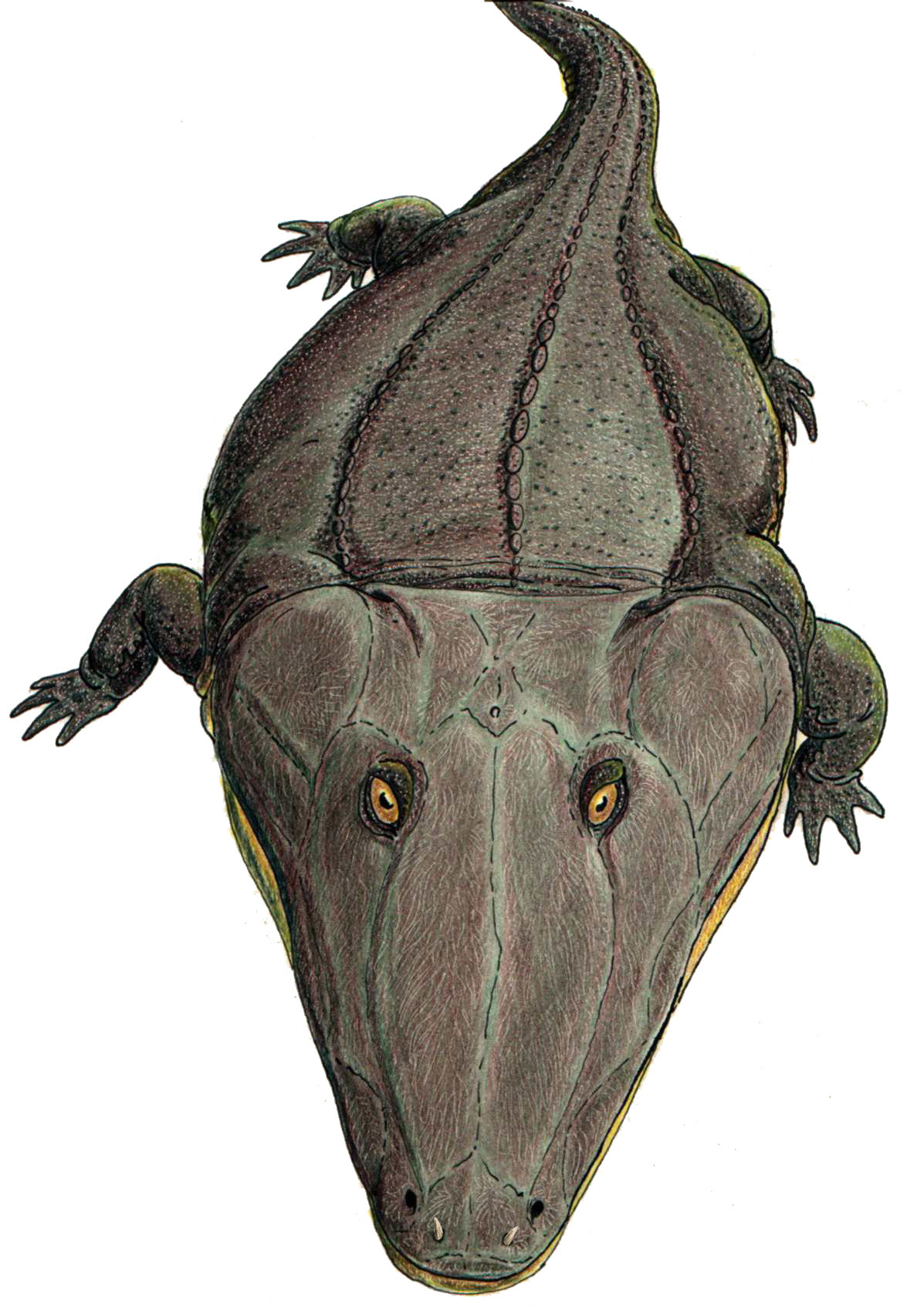|
Eryosuchus BW
''Eryosuchus'' is an extinct genus of capitosauroid temnospondyl from the Middle Triassic of northern Russia. It was a very large predator: the largest specimen known could reach up to 3.5 m (11.5 ft) in length, with a skull over 1 m long. History of study ''Eryosuchus'' was named by Ochev (1966) based on the type species, ''E. tverdochlebovi'' from exposures of the Donguz Formation in Orenburgskaya Oblast. In the same publication, Ochev also named ''E. garjainovi'' and ''E. antiquus'', both from the same formation and oblast as ''E. tverdochlebovi''. Several other species previously placed in other genera have sometimes been placed in ''Eryosuchus'', such as "''Stanocephalosaurus''" ''pronus'' from Tanzania and ''"''Stanocephalosaurus" ''rajareddyi'' from India, but this is largely disputed, as is the validity of ''E. antiquus'', which is only based on a lower jaw fragment. These species, as well as more confidently assigned species of ''Eryosuchus,'' were sometimes ... [...More Info...] [...Related Items...] OR: [Wikipedia] [Google] [Baidu] |
Type Species
In International_Code_of_Zoological_Nomenclature, zoological nomenclature, a type species (''species typica'') is the species name with which the name of a genus or subgenus is considered to be permanently taxonomically associated, i.e., the species that contains the biological Type (biology), type wiktionary:en:specimen, specimen (or specimens). Article 67.1 A similar concept is used for suprageneric groups and called a type genus. In botanical nomenclature, these terms have no formal standing under the International Code of Nomenclature for algae, fungi, and plants, code of nomenclature, but are sometimes borrowed from zoological nomenclature. In botany, the type of a genus name is a specimen (or, rarely, an illustration) which is also the type of a species name. The species name with that type can also be referred to as the type of the genus name. Names of genus and family ranks, the various subdivisions of those ranks, and some higher-rank names based on genus names, have suc ... [...More Info...] [...Related Items...] OR: [Wikipedia] [Google] [Baidu] |
Uranocentrodon Senekalensis
''Uranocentrodon'' is an extinct genus of temnospondyls in the family Rhinesuchidae. Known from a skull, ''Uranocentrodon'' was a large predator with a length up to . Originally named ''Myriodon'' by van Hoepen in 1911, it was transferred to a new genus on account of the name being preoccupied in 1917. It has been synonymized with '' Rhinesuchus'', but this has not been widely supported. It was also originally considered to be of Triassic age, but more recent analysis has placed its age as just below the Permian-Triassic boundary. History and specimens Fossils of the animal now known as ''Uranocentrodon'' were first discovered in a sandstone quarry in the Normandien Formation near Senekal in Free State, South Africa. The first example of these fossils was a fragmentary skull excavated by a local family. Subsequent excavations and searches undertaken by various parties unearthed more specimens which hailed from the quarry. Among these specimens included three nearly complete ... [...More Info...] [...Related Items...] OR: [Wikipedia] [Google] [Baidu] |
Quasicyclotosaurus Campi
''Quasicyclotosaurus'' is an extinct genus of mastodonsauroid temnospondyl. It had a closed otic notch. See also * Prehistoric amphibian * List of prehistoric amphibians This list of prehistoric amphibians is an attempt to create a comprehensive listing of all genera from the fossil record that have ever been considered to be amphibians, excluding purely vernacular terms. The list includes all commonly accepted gen ... References Capitosauria Triassic temnospondyls of North America Fossil taxa described in 2000 {{temnospondyli-stub ... [...More Info...] [...Related Items...] OR: [Wikipedia] [Google] [Baidu] |
Eocyclotosaurus
''Eocyclotosaurus'' (Greek ‘èoos’ = dawn, ‘kyklos’ = circle, 'ous' = ear ) is an extinct genus of mastodonsauroid temnospondyl from the Middle Triassic (Anisian). The name ''Eocyclotosaurus'' means "dawn round-eared lizard". It is characterized as a capitosauroid with a long and slender snout, closed otic fenestra, and small orbits. It measured over one metre and had a 22 cm skull. It lived between 247 and 242 million years ago in both North America, Germany, France and the British Isles during the early Triassic. Discovery and naming The genus ''Eocyclotosaurus'' was named by Dieter Ortlam in 1970. The type species is ''Eocyclotosaurus woschmidti'', the specific name honouring Wolfgang Schmidt. Description Compered to '' Cyclotosaurus'', ''Eocyclotosaurus'' has a similar morphology in postorbital division of the skull. However, in ''Eocyclotosaurus'' the depth of the occiput is greater. Skull The species is narrow-headed. Orbits were smaller in ''Eocyclotosaur ... [...More Info...] [...Related Items...] OR: [Wikipedia] [Google] [Baidu] |
Procyclotosaurus Stantonensis
''Procyclotosaurus'' is an extinct genus of stenotosaurid capitosaurian temnospondyl. The type species is ''P. stantonensis''. In 1904, English paleontologist Arthur Smith Woodward described it as a species of '' Capitosaurus'', ''C. stantonensis'', based on a partial skull known as R 3174. In 1958, the species was assigned to the new genus. It is known from the Lower Keuper, a European stratigraphic unit that was deposited during the late Middle Triassic.Witzmann, Florian & Sachs, Sven & Nyhuis, Christian. (2016). A new species of Cyclotosaurus (Stereospondyli, Capitosauria) from the Late Triassic of Bielefeld, NW Germany, and the intrarelationships of the genus. Fossil Record. 19. 83-100. 10.5194/fr-19-83-2016. Fossils have been found from Staffordshire, England. Description ''Procyclotosaurus'' was a relatively small temnospondyl. Unlike most other capitosaurs, which have wide and flat skulls, ''Procyclotosaurus'' has a deep, wedge-shaped skull. The otic notch, a notch at t ... [...More Info...] [...Related Items...] OR: [Wikipedia] [Google] [Baidu] |
Stanocephalosaurus Birdi
''Stanocephalosaurus'' (stano from Greek stenos, meaning “narrow”, cephalo from Greek kephalē, meaning “head”) is an extinct genus of large-sized temnospondyls living through the early to mid Triassic. The etymology of its name most likely came from its long narrow skull when compared to other temnospondyls. ''Stanocephalosaurus'' lived an aquatic lifestyle, with some species even living in salt lakes. There are currently three recognized species and another that needs further material to establish its legitimacy. The three known species are ''Stanocephalosaurus pronus'' from the Middle Triassic in Tanzania, ''Stanocephalosaurus amenasensis'' from the Lower Triassic in Algeria, and ''Stanocephalosaurus birdi'', from the middle Triassic in Arizona. ''Stanocephalosaurus rajareddyi'' from the Middle Triassic in central India needs further evidence in order to establish its relationship among other Stanocephalosaurs. Like other temnospondyls, ''Stanocephalosaurus'' was an aqu ... [...More Info...] [...Related Items...] OR: [Wikipedia] [Google] [Baidu] |
Paracyclotosaurus Crookshanki
''Paracyclotosaurus'' (meaning "Near Wheeled Lizard") is an extinct genus of temnospondyl, which would have appeared similar to today's salamander – but much larger, measuring up to long and weighing between . It lived in the Middle Triassic period, about 235 million years ago, and fossils have been found in Australia, India, and South Africa. Although they could live on dry land, ''Paracyclotosaurus'' probably spent most of its time in water. They had flattened bodies and elongated heads, almost long, that vaguely resembled those of modern crocodiles. Discovery and naming The type species ''P. davidi'' is only known from one complete specimen recovered from Australia. It was discovered by quarry miners in a brick pit in St. Peters in Sydney, New South Wales. The discovery, made in 1910, was from a large ironstone nodule within Ashfield Shale which contained the nearly complete skeleton. The reconstruction was finished in July 1914, and was initially determined to be clos ... [...More Info...] [...Related Items...] OR: [Wikipedia] [Google] [Baidu] |
Cherninia Denwai
''Cherninia'' is an extinct genus of mastodonsaurid temnospondyl known from the Denwa Formation of India and the Ntawere Formation of Zambia. Discovery and species The type species, ''Cherninia denwai'', is known from the Denwa Formation. It is based on a massive skull, ISI A 54, which was originally considered a species of ''Parotosuchus'' in 1998 before being given its own genus in 2001. Another species, ''Cherninia megarhina'', is known from the Upper Ntawere Formation. ''C. megarhina'' is based on another large skull, BP/1/4223, which had also been previously referred to ''Parotosuchus''. Though not as well-preserved as the skull of ''C. denwai'', BP/1/4233 was described earlier in 1974. It was described by Sharon Chernin, a paleontologist at the Bernard Price Institute and the namesake of the genus. Description ''Cherninia denwai'' was initially described on the basis of cranial material from the Denwa Formation. A redescription in 2024 described new material from ... [...More Info...] [...Related Items...] OR: [Wikipedia] [Google] [Baidu] |
Xenotosuchus Africanus
''Xenotosuchus'' is an extinct genus of mastodonsaurid temnospondyl within the family Mastodonsauridae known from the Triassic of South Africa. The genus is based on a skull originally described as ''Parotosuchus'', an animal which it resembled in general build and habit. Description Like many mastodontosaurids, it was a large animal with a large head. Its amphibian Amphibians are ectothermic, anamniote, anamniotic, tetrapod, four-limbed vertebrate animals that constitute the class (biology), class Amphibia. In its broadest sense, it is a paraphyletic group encompassing all Tetrapod, tetrapods, but excl ... life history meant that the distinct shape of the skull roof would change from a generalized tadpole-like skull type through to the distinct adult shape. The head bones are covered in large pits and grooves, indicating extensive dermal armour on the head. Both the upper and lower jaw had tusks, those of the upper jaw being situated on a 2nd row of teeth on the vomer ... [...More Info...] [...Related Items...] OR: [Wikipedia] [Google] [Baidu] |
Watsonisuchus
''Watsonisuchus'' is an extinct genus of temnospondyl from the Early Triassic of Australia, Madagascar, and South Africa. It was up to 122 cm long and had a robust skull of 24 cm in length. Three or four species are known:'Dragons in the Dust: The Paleobiology of the Giant Monitor Lizard Megalania'' by Ralph E. Molnar (Pg. 39) ''W. magnus'' (the type species In International_Code_of_Zoological_Nomenclature, zoological nomenclature, a type species (''species typica'') is the species name with which the name of a genus or subgenus is considered to be permanently taxonomically associated, i.e., the spe ...), ''W. aliciae'' (which may instead belong to '' Warrenisuchus''), ''W. gunganj'', and ''W. rewanensis''. References Capitosauria Triassic temnospondyls of Africa Triassic temnospondyls of Australia Early Triassic amphibians of Africa Fossil taxa described in 1966 {{Temnospondyli-stub ... [...More Info...] [...Related Items...] OR: [Wikipedia] [Google] [Baidu] |
Edingerella Madagascariensis
''Edingerella'' is an extinct genus of temnospondyl amphibian from the Early Triassic of Madagascar. It is a basal capitosaur closely related to '' Watsonisuchus''. Phylogeny Below is a cladogram A cladogram (from Greek language, Greek ''clados'' "branch" and ''gramma'' "character") is a diagram used in cladistics to show relations among organisms. A cladogram is not, however, an Phylogenetic tree, evolutionary tree because it does not s ... from Fortuny et al. (2011): References Capitosauria Triassic temnospondyls of Africa Prehistoric animals of Madagascar Early Triassic amphibians of Africa {{temnospondyli-stub ... [...More Info...] [...Related Items...] OR: [Wikipedia] [Google] [Baidu] |




